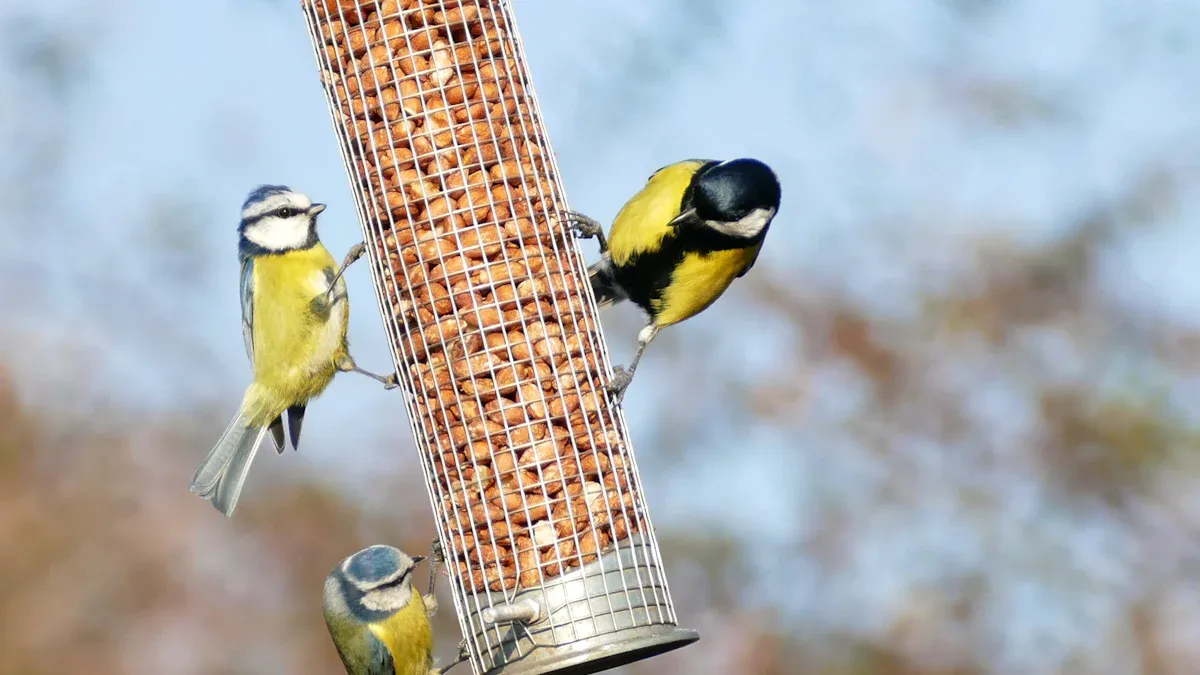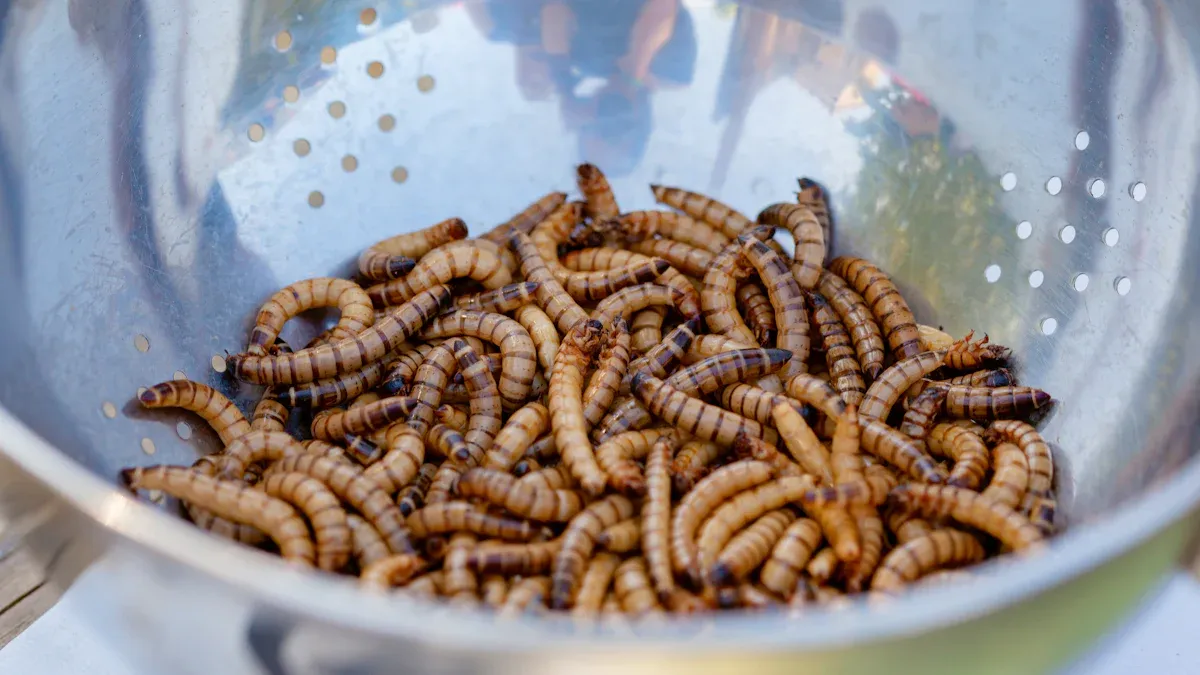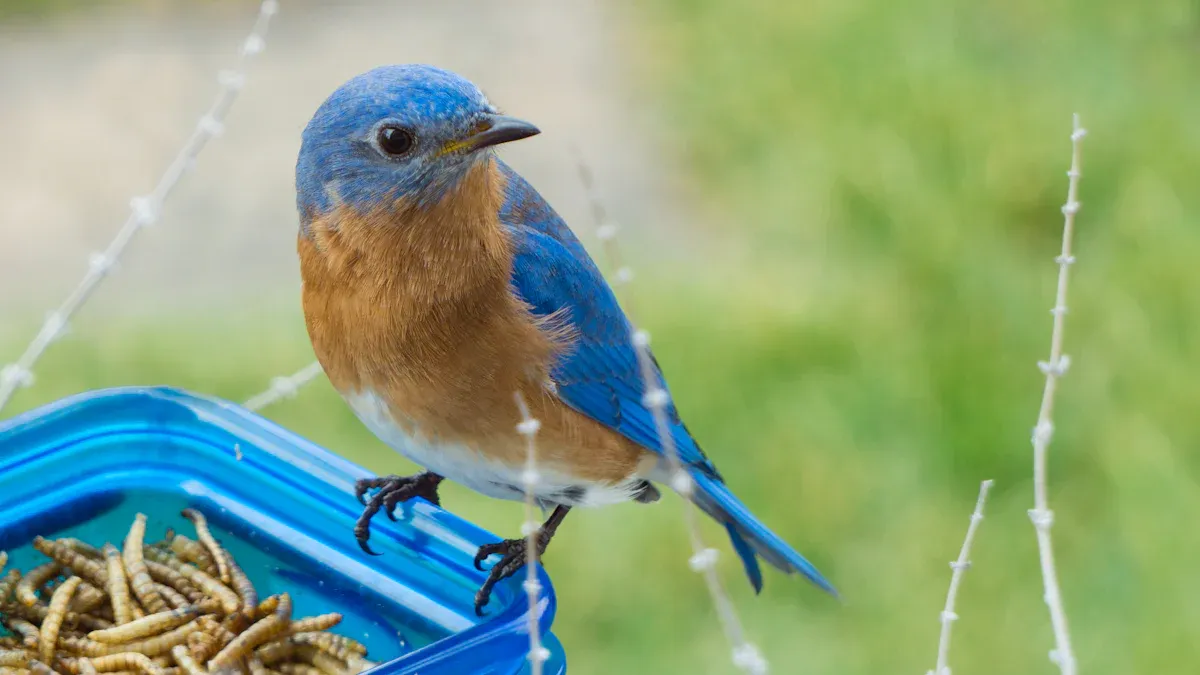
Dried mealworms for birds are a powerhouse of nutrition. Packed with protein, fat, and carbohydrates, they’re perfect for keeping wild birds healthy and energized. You can feed them year-round, but they’re especially helpful in winter and nesting seasons when birds need extra energy to stay warm or care for their young.
Key Takeaways
- Dried mealworms have lots of protein, fat, and fiber. They are a great food for wild birds in winter or nesting times.
- Giving dried mealworms can bring many birds to your yard. Birds like bluebirds, chickadees, and robins may visit, making bird-watching more fun.
- To keep mealworms fresh, store them in a cool, dry spot. You can soak them in water before feeding to give nesting birds extra water.
Nutritional Benefits of Dried Mealworms for Birds

Protein for Growth and Feather Development
Protein is one of the most important nutrients for wild birds. It helps them grow strong and develop healthy feathers. Dried mealworms for birds are an excellent source of protein, containing about 50-55% crude protein. This makes them one of the most nutrient-dense options compared to other bird foods.
| Nutrient | Amount |
|---|---|
| Crude Protein | 50% – 55% |
| Crude Fat | 24-25% (min.) |
| Crude Fiber | 6-9% (min.) |
| Moisture | 4-6% |
Feathers are made of keratin, a protein that birds need to replace during molting. By offering dried mealworms, you’re giving birds the fuel they need to grow new feathers and maintain their vibrant plumage.
Healthy Fats for Energy and Endurance
Birds burn a lot of energy flying, especially during migration or cold winter months. The healthy fats in dried mealworms provide a quick and efficient energy source. These fats make up about 28% of their nutritional content, giving birds the endurance they need to survive harsh conditions.
| Nutrient | Dried Mealworms |
|---|---|
| Lipid (Fat) | 28% |
| Protein | 53% |
| Carbohydrate | 8.5% |
Mealworms can be fed to wild birds all year round, but they’re particularly beneficial during winter when high-fat foods are essential. They’re also perfect during nesting season, helping parent birds stay energized while caring for their chicks.
Fiber and Micronutrients for Overall Health
Dried mealworms for birds don’t just provide protein and fat—they also contain fiber and essential micronutrients. Fiber supports digestion, while vitamins and minerals help maintain overall health. These nutrients are especially important for migratory birds, as they need to stay in peak condition for long journeys.
By including dried mealworms in your bird-feeding routine, you’re offering a well-rounded diet that supports growth, energy, and health. It’s a simple way to help your feathered friends thrive.
Birds That Thrive on Dried Mealworms
Common Backyard Birds
If you’re looking to attract a variety of backyard birds, dried mealworms are a fantastic choice. Many common species love them, and they’ll keep coming back for more. Here’s a quick list of birds you might spot enjoying this protein-packed treat:
- Bluebirds
- Chickadees
- Thrushes
- Titmice
- Wrens
- Nuthatches
- Kinglets
Bluebirds, in particular, are big fans of dried mealworms, especially during nesting season when they need extra protein. Robins, known for their ground-foraging habits, also benefit from mealworms when natural food sources are scarce. Chickadees, with their playful feeding antics, will happily snack on mealworms too. Even woodpeckers, like Downy and Red-bellied species, enjoy them as a supplemental food source. By offering dried mealworms, you’ll create a lively and diverse bird-watching experience right in your backyard.
Migratory and Seasonal Visitors
Dried mealworms for birds are especially helpful for migratory species. These birds travel long distances and need high-energy foods to fuel their journeys. You might notice bluebirds, robins, and chickadees stopping by your feeder during migration seasons. Woodpeckers and nuthatches also benefit from the protein-rich diet that mealworms provide. Adding mealworms to your feeder during these times can make a big difference for these seasonal visitors.
Tip: Place mealworms in an open tray feeder or scatter them on the ground to attract ground-foraging birds like robins.
Nesting Birds with High Nutritional Needs
Parent birds work tirelessly during nesting season to feed their chicks. They need a diet rich in protein and fat to stay energized. Dried mealworms are an excellent choice for these busy parents. However, keep in mind that dried mealworms lack hydration, which is essential for nestlings. If you’re feeding nesting birds, consider soaking the mealworms in water to make them easier to digest.
| Aspect | Live Mealworms | Dried Mealworms |
|---|---|---|
| Nutritional Value | High in hydration and energy | Lower hydration, can dehydrate nestlings |
| Energy Conservation | Reduces foraging time | Requires more foraging effort |
| Recommended Use During Nesting | Preferred for nestlings’ hydration | Not recommended, can be soaked in emergencies |
Mealworms can be fed to wild birds all year round, but they’re particularly beneficial during winter when high-protein and high-fat foods are most valuable. They’re also great during nesting season for keeping busy parent birds energized. By including dried mealworms in your feeding routine, you’ll support birds during their most demanding times.
Comparing Dried Mealworms to Other Food Sources
Dried vs. Live Mealworms
You might wonder whether dried or live mealworms are better for wild birds. Both options are nutritious, but dried mealworms have a slight edge. The drying process removes water, concentrating the nutrients. This means dried mealworms contain more protein and fat per gram compared to live ones. They’re an excellent choice when you want to provide a high-energy snack for your feathered visitors.
Live mealworms, on the other hand, offer hydration, which is essential during hot weather or for nestlings. However, they require refrigeration and careful handling, which can be inconvenient. Dried mealworms are shelf-stable and ready to use, making them a practical alternative. You can even soak them in water to rehydrate them if needed.
Mealworms can be fed to wild birds all year round, but they’re particularly beneficial during the winter periods when high-protein and high-fat foods are the most valuable. They’re also great during the nesting season for keeping busy parent birds suitably energized.
Advantages Over Other Insect-Based Foods
Dried mealworms stand out among insect-based bird foods for several reasons:
- They come in resealable bags, keeping them fresh without refrigeration.
- Their shelf-stable nature makes them easy to store and transport.
- You can feed them directly or rehydrate them for a softer texture.
- They retain their nutritional value, providing a reliable food source for birds.
These advantages make dried mealworms a versatile and convenient option for bird enthusiasts like you.
Convenience and Storage Benefits
Storing dried mealworms is a breeze compared to live ones. Live mealworms need refrigeration, which can be a hassle. Dried mealworms, however, don’t require refrigeration. You can keep them in a cool, dry place, and they’ll stay fresh for months.
Their dehydrated state preserves their nutrients while eliminating the need for live storage. This makes them easy to handle and perfect for year-round feeding. Whether you’re feeding birds in winter or during nesting season, dried mealworms are a practical and nutritious choice.
Feeding Dried Mealworms to Wild Birds

Selecting the Right Feeder
Choosing the right feeder makes a big difference when offering dried mealworms to wild birds. You want a feeder that keeps the mealworms secure and fresh. Look for feeders with tall sides to stop the mealworms from spilling out. A roof or baffle is also helpful since it protects the food from rain. Drainage holes are another must-have feature. They prevent water from pooling and keep the mealworms dry.
If squirrels are common in your area, consider a feeder with squirrel-proof features. These feeders help ensure that the mealworms go to the birds, not the local wildlife. You can also use an open tray feeder or scatter mealworms on the ground to attract ground-feeding birds like robins.
Seasonal Feeding Tips
Mealworms can be fed to wild birds all year round, but their benefits shine during certain seasons. In winter, birds need extra fat to stay warm. Dried mealworms provide the energy they need to survive the cold. During spring, birds require more protein for growth, feather development, and egg-laying. Parent birds also need high-protein foods to feed their chicks.
Tip: Soak dried mealworms in water during nesting season. This adds hydration, making them easier for parent birds to feed their young.
Combining Mealworms with Other Bird Foods
Dried mealworms for birds are packed with nutrients, but birds thrive on variety. Mixing mealworms with fruits, vegetables, and grains creates a balanced diet. High-quality mealworms without preservatives are the best choice. Use different feeder types to attract a wide range of bird species. A mix of protein, fruits, and grains ensures that all your feathered visitors get the nutrition they need.
Best Practices for Storing Dried Mealworms
Keeping Mealworms Fresh
To keep dried mealworms fresh, you’ll want to store them in the right conditions. A cool, dry place is ideal because it prevents mold and mites from forming. Aim for a storage temperature between 40-50°F (4-10°C). This slows down any potential spoilage and keeps the mealworms in top condition.
Proper ventilation is also key. Use containers with small holes or mesh lids to allow airflow and reduce condensation. Label your containers with the storage date so you can rotate your stock and use the oldest mealworms first. This simple habit ensures you’re always offering fresh food to your feathered visitors.
Tip: Keep your mealworms in a dark or dimly lit area. This reduces stress on the mealworms and helps maintain their quality.
Preventing Moisture and Contamination
Moisture is the enemy when it comes to storing dried mealworms. It can lead to mold growth and contamination. To avoid this, always check your storage area for dampness. If you notice any moisture, add a paper towel to the container to absorb it.
Regularly inspect your mealworms for signs of mold, mites, or waste buildup. If you spot any issues, clean the container and refresh the bedding material. Using plastic containers with ventilation holes is a great way to keep the mealworms dry and safe.
Note: Avoid exposing mealworms to direct light. This not only prevents contamination but also helps them stay fresh longer.
Long-Term Storage Solutions
For long-term storage, focus on temperature, humidity, and ventilation. Keep the mealworms at 40-50°F (4-10°C) to maintain their quality over time. A moderately dry environment is crucial, so consider using a paper towel to manage humidity levels.
Ventilation is equally important. Containers with small holes allow airflow, preventing condensation and keeping the mealworms dry. If you’re storing mealworms for an extended period, refresh the bedding every few weeks to maintain cleanliness and reduce the risk of mold.
By following these steps, you can ensure your dried mealworms remain fresh and nutritious, ready to support wild birds all year round.
Dried Mealworms for birds are a simple yet powerful way to support their health and energy needs. They’re packed with nutrients that attract a wide variety of species, including chickadees, cardinals, and bluebirds. By adding them to your feeding routine, you’ll create a lively backyard and enjoy a deeper connection with nature.
“The connection that is created between people and nature from feeding birds—that is indisputable,” said Emma Greig, the project leader of Project FeederWatch.
Mealworms can be fed to wild birds all year round, but they’re particularly beneficial during the winter periods when high-protein and high-fat foods are the most valuable. They’re also great during the nesting season for keeping busy parent birds suitably energized. Start today and watch your feathered friends thrive!
FAQ
How often should I feed dried mealworms to wild birds?
You can offer dried mealworms daily. Birds benefit from consistent feeding, especially during winter and nesting seasons when they need extra energy.
Can I mix dried mealworms with other bird foods?
Absolutely! Mixing mealworms with seeds, fruits, or suet creates a balanced diet. This variety attracts more bird species to your feeder.
Tip: Use separate feeders for different food types to reduce competition among birds.
Are dried mealworms safe for baby birds?
Yes, but soak them in water first. This adds hydration, making them easier for parent birds to feed their chicks during nesting season.
Note: Hydration is crucial for nestlings’ digestion and growth.


